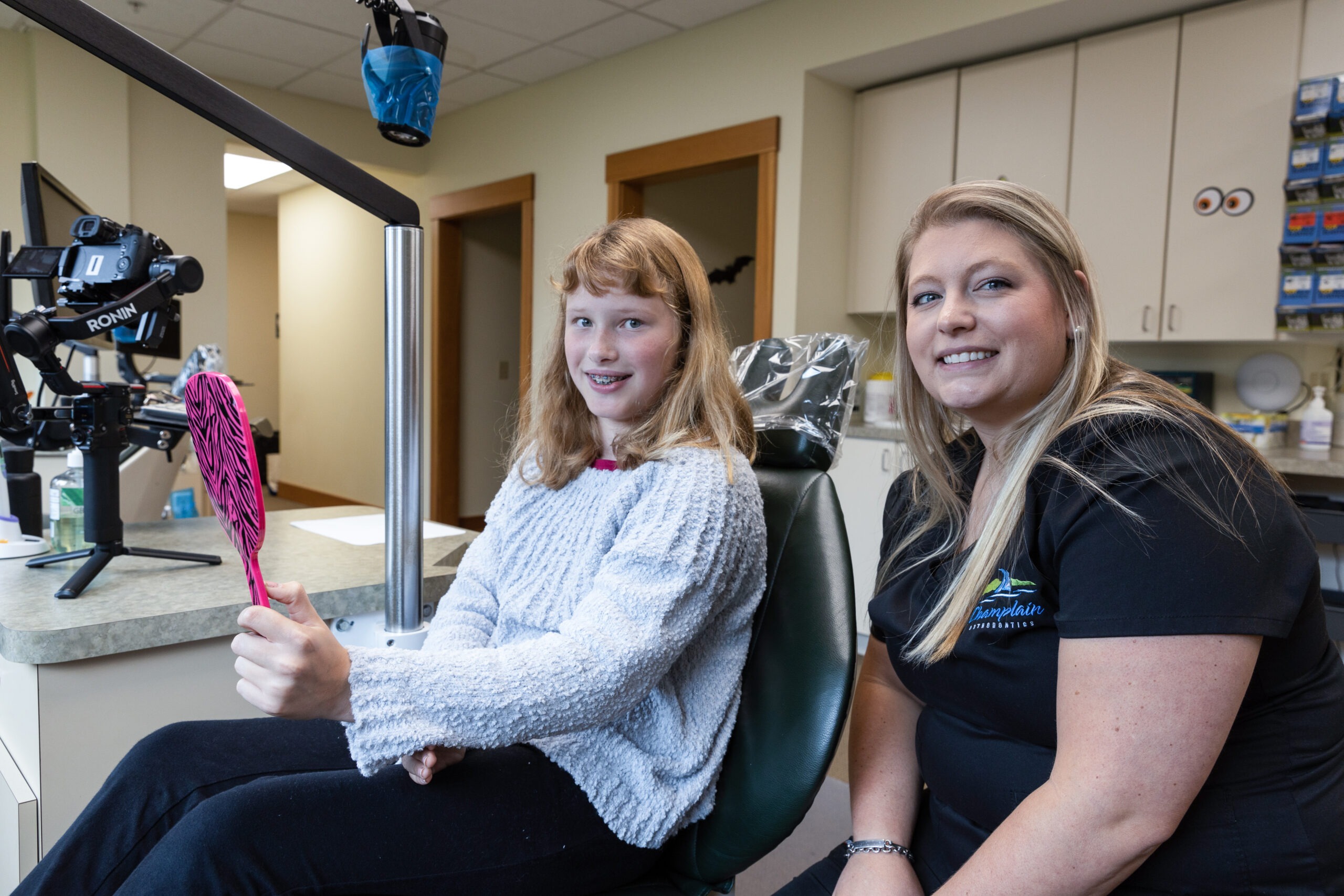At Champlain Orthodontics, you can count on our knowledgeable team to offer comprehensive care and help make your time in treatment as easy as possible. To help answer some of your preliminary questions about braces, we have compiled the essentials so you can start your journey one step ahead of the game! Whether you are wondering how braces work, how each part of the appliance works or what post-treatment looks like, read on to learn more today!
So, What are Braces?
Champlain Orthodontics has been providing care to our patients for many years, including the treatment of choice: braces. Braces are able to align both your teeth and jaw to the perfect position to create your ideal smile. While many associate receiving them during their teenage years, it is also widely available to adults who can achieve equally effective results.
They can relieve orthodontic issues such as crowded or gapped teeth, jaw pain, impacted teeth, malocclusion, and bite complications. They improve oral health, reinvent confidence, and offer easier sleep at night. No issue is too complex to be treated with braces.
Care Changes As Age Does
The treatment process for an adult versus a child certainly differs, but they share the same goal. Because children’s bones are still growing, their jaws are more easily molded to the shape necessary for the smile treatment. On the other hand, adults’ bones stop growing at the end of their teens and require a little longer with their braces to reach the same results.
Kids may also benefit from participating in two-phase treatment in which Dr. Ryan and Dr. Eaton treat early issues around seven years old to avoid more complicated treatments when the traditional time for braces comes around. Remember, you can always start your treatment at any time!
Select Your Treatment Option
LightForce Clear Braces
Offering state-of-the-art care, LightForce clear braces offer a discreet look with excellent results. They are constructed with custom 3-D printed braces to fix your teeth as if they aren’t even there! They reduce the number of office visits and sometimes your treatment time. Thanks to our detailed models, we can see how your teeth will move before you even wear the appliance.
Metal Braces
Often referred to as a long-trusted treatment, metal braces are a traditional option that hold the power to fix just about any orthodontic issue. No longer the bulky and uncomfortable appliance it was, these are as sleek and light as they come, thanks to orthodontic advancements. Metal braces are known for their reliability and effectiveness.
Do Braces Permanently Straighten Teeth?
Braces can set your teeth in the perfect place, but keeping them there after your appliance is taken out is up to you. To maintain your treatment, Champlain Orthodontics provides each patient with a retainer to ensure your perfect smile isn’t going anywhere!
Retainers come as either fixed or removable appliances. Fixed retainers are smooth metal wires permanently placed on the back of your upper and lower teeth. Taking the extra time to floss and brush the wires properly ensures they stay in top condition.
Removable appliances accomplish the same job but work a little differently. Dr. Ryan and Dr. Eaton recommend you wear your retainer full-time for about half a year before transitioning to only keeping it in during the nighttime. Because this retainer does not live inside your mouth, you must remember when to take it out and keep it in.

How Each Part Works Together
Archwire
Your brackets connect the long archwire across the front of your teeth, which is crucial in establishing how much pressure is placed on them and where so they shift in the right direction.
Glue
Used to attach brackets to your teeth, a special orthodontic adhesive called bonding cement ensures nothing loosens from its place during your time with us.
Brackets
As a fastener for many other parts of your braces, brackets are small square-shaped pieces affixed to each tooth’s front surface.
Rubber Bands
As strong as the archwire is, rubber bands sometimes need to swoop in and help with aligning by applying additional pressure on both your jaw and particular teeth. They are placed on your upper and lower brackets.
Spacers
Tiny elastic rings, or spacers, are placed between your teeth when space needs to be made due to crowding or when a metal band needs to be placed on your back molars.
Metal Bands
Used to anchor your archwire in place, bands are custom-made appliances often made of metal placed on your back molars. Not every patient’s case may necessitate this, but Dr. Ryan and Dr. Eaton may recommend it to make your treatment more efficient.
Be Prepared with a Braces Care Kit
Floss and Threaders:
When small pieces of food get stuck in your appliance or gums, it can be difficult to fish them out. Floss sticks will get stopped halfway through your tooth due to the archwire, so regular string floss with a special threader provided by our office can do wonders.
Toothbrush and Paste:
If you brush your teeth after each meal, you can keep your braces in tip-top condition at all times. Reaching every corner with your toothbrush can help eliminate tiny pieces of food stuck in your braces. Swishing with water is another way you can keep them clean.
Orthodontic Wax:
If a part of your appliance starts feeling sharp against your tongue or gums, tear off a small amount of orthodontic wax and flatten it flush against it. This will avoid any irritation and is even harmless if it is ingested.

Your Chance For Braces Awaits!
Our friendly experts are always eager to help new patients begin treatment at our St. Alba and Williston offices. No matter where you are in your dental journey, our high-quality orthodontic services can accommodate your needs. Feel free to contact us today and schedule your free in-office or virtual consultation. Take the next step toward a beautiful smile!
 Free Consult
Free Consult
